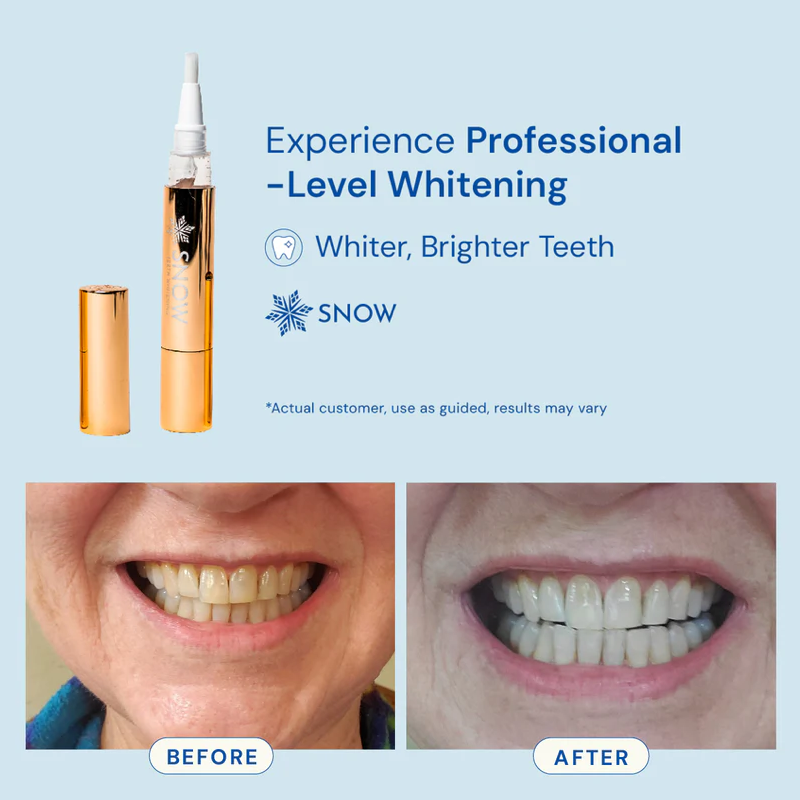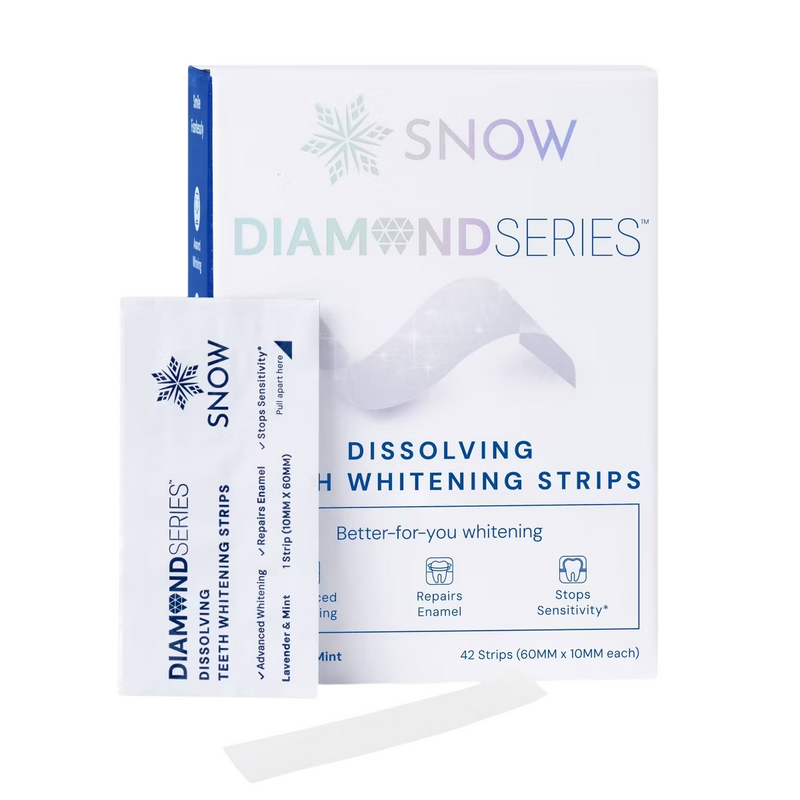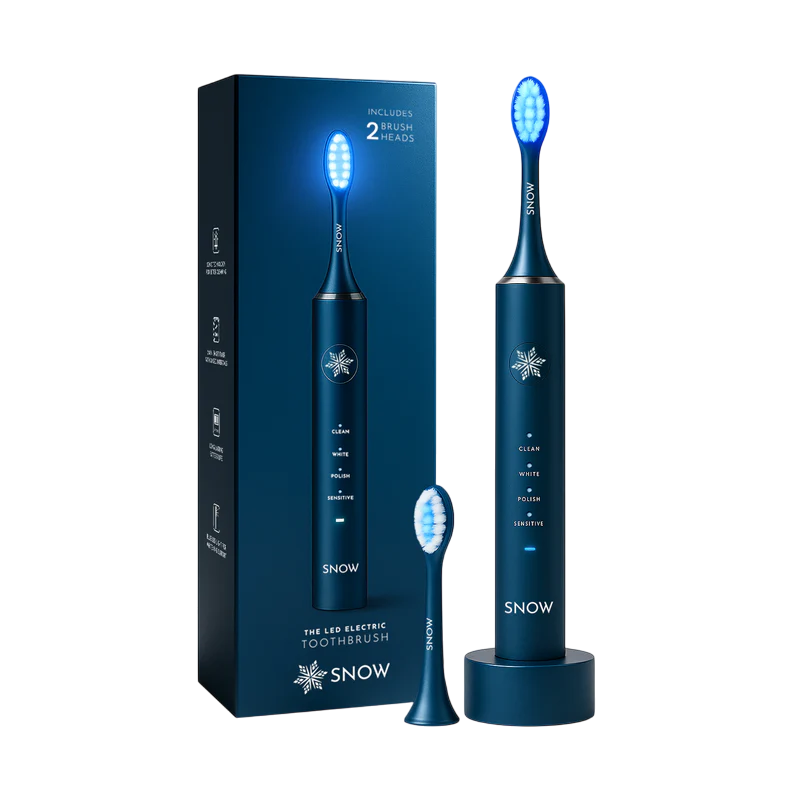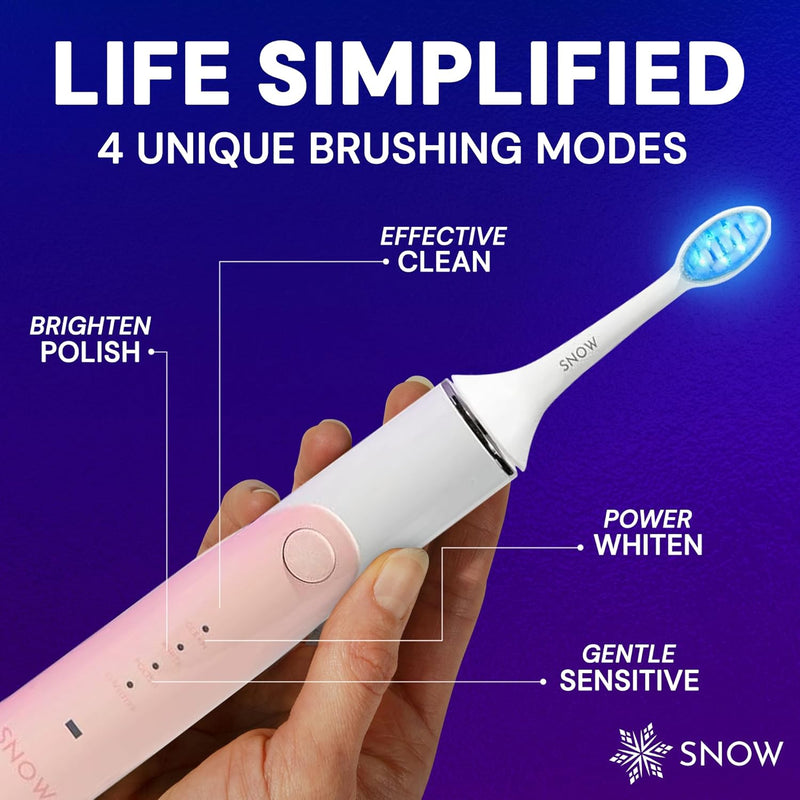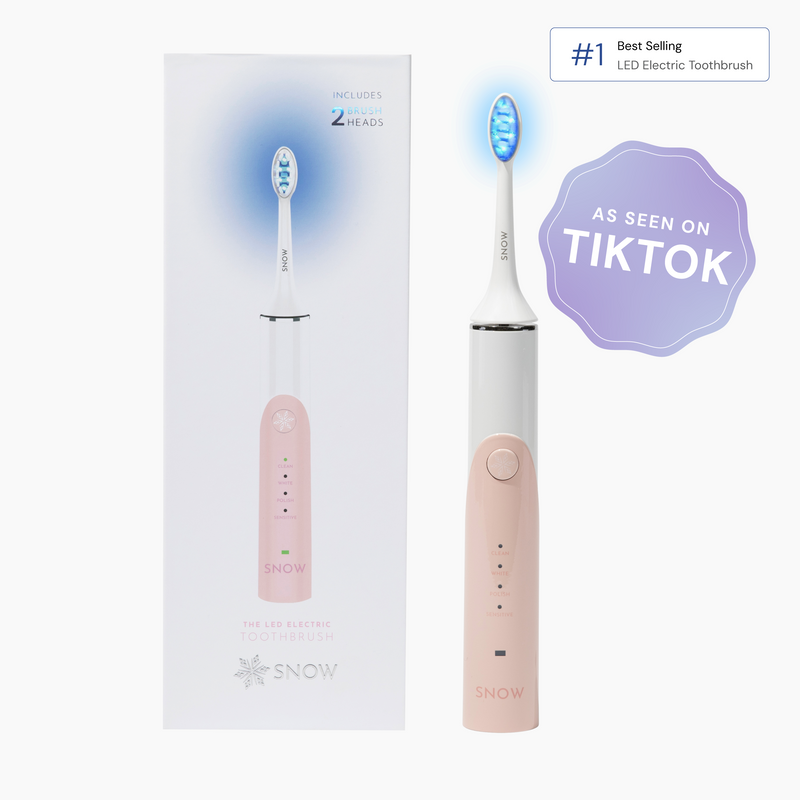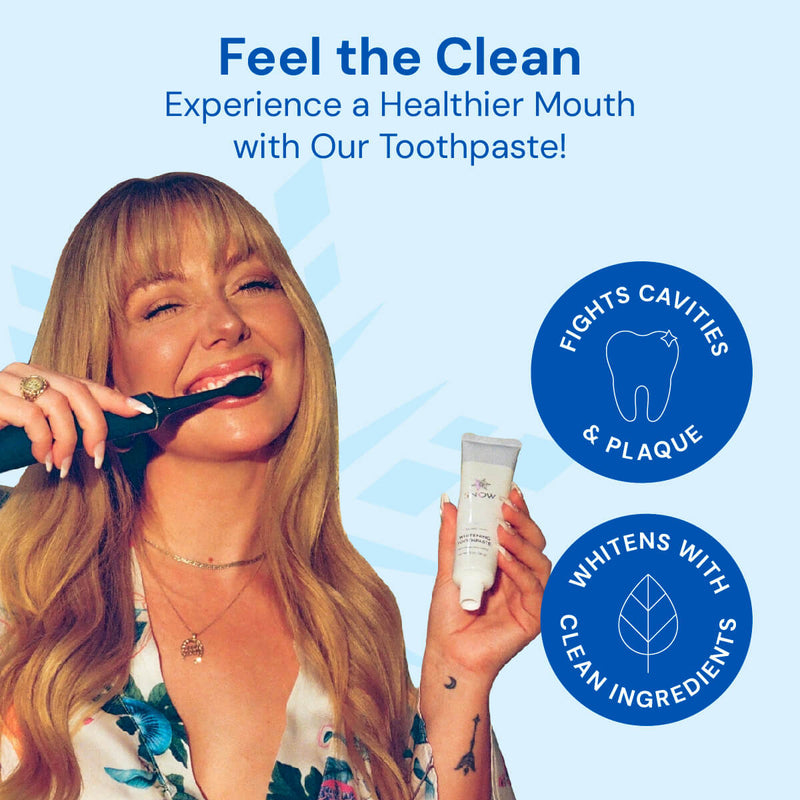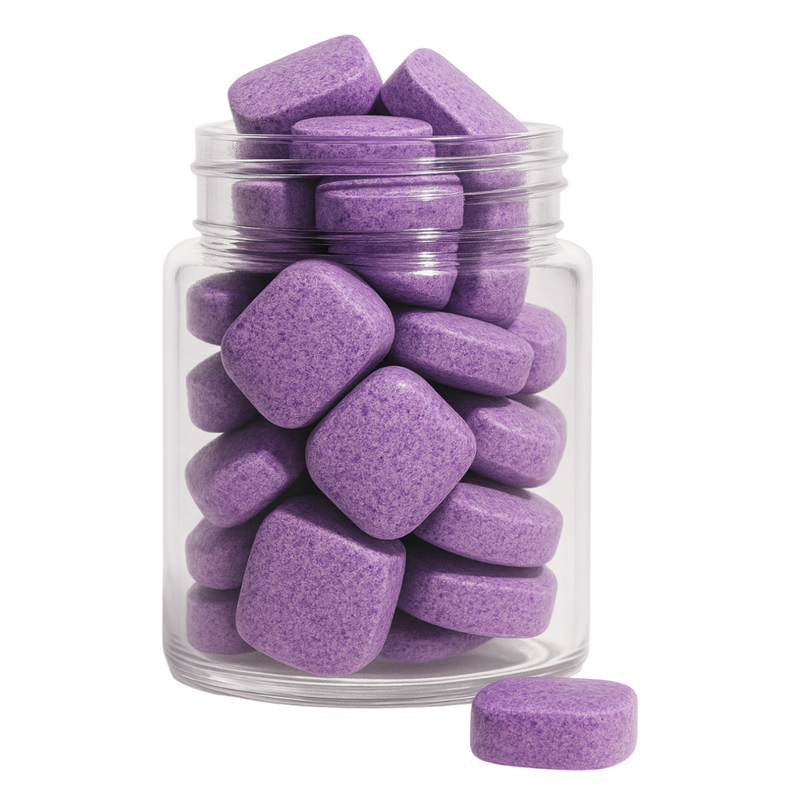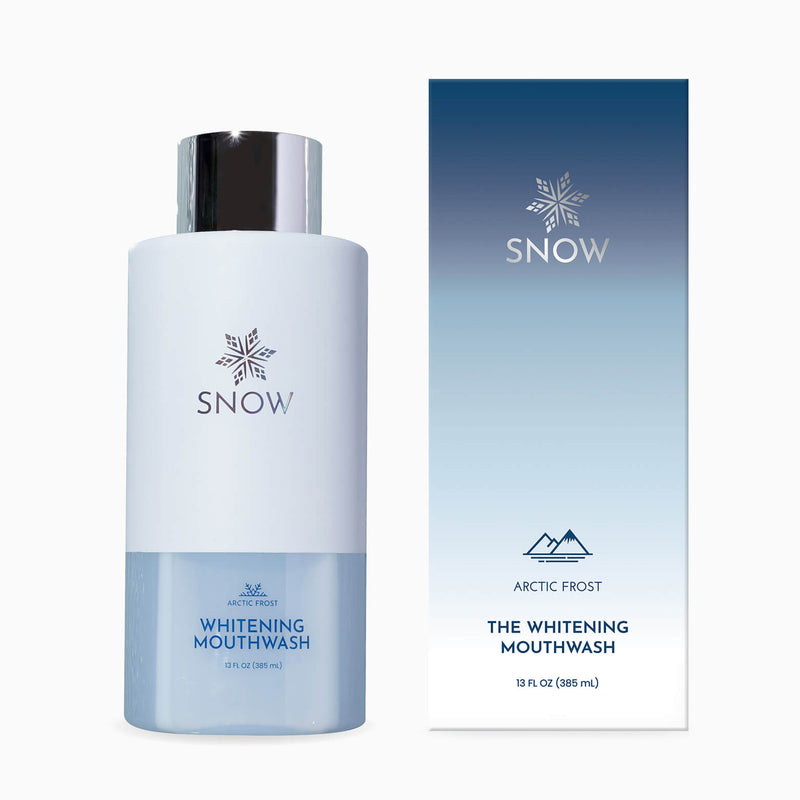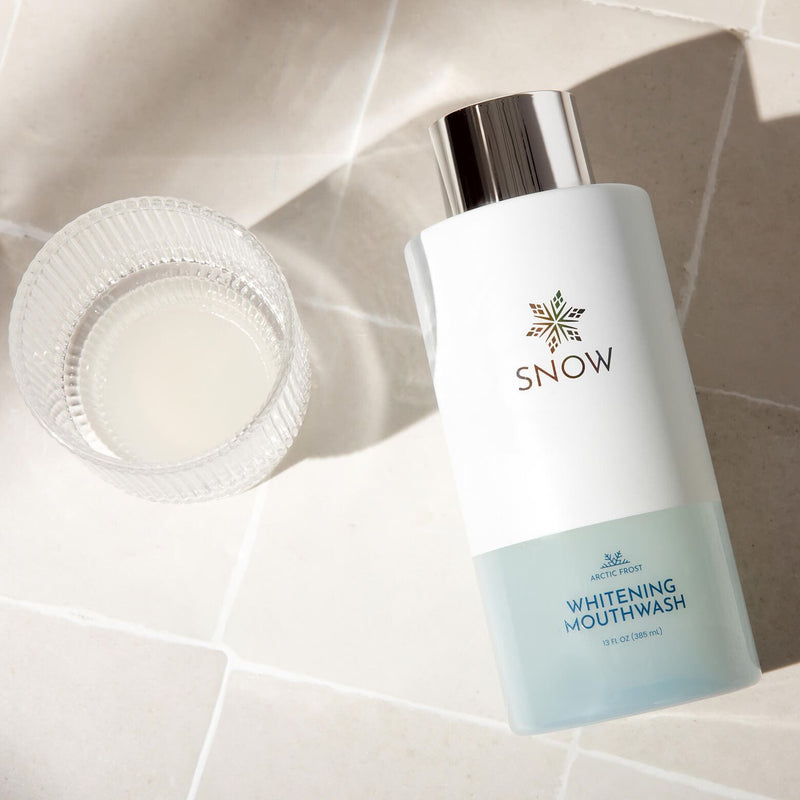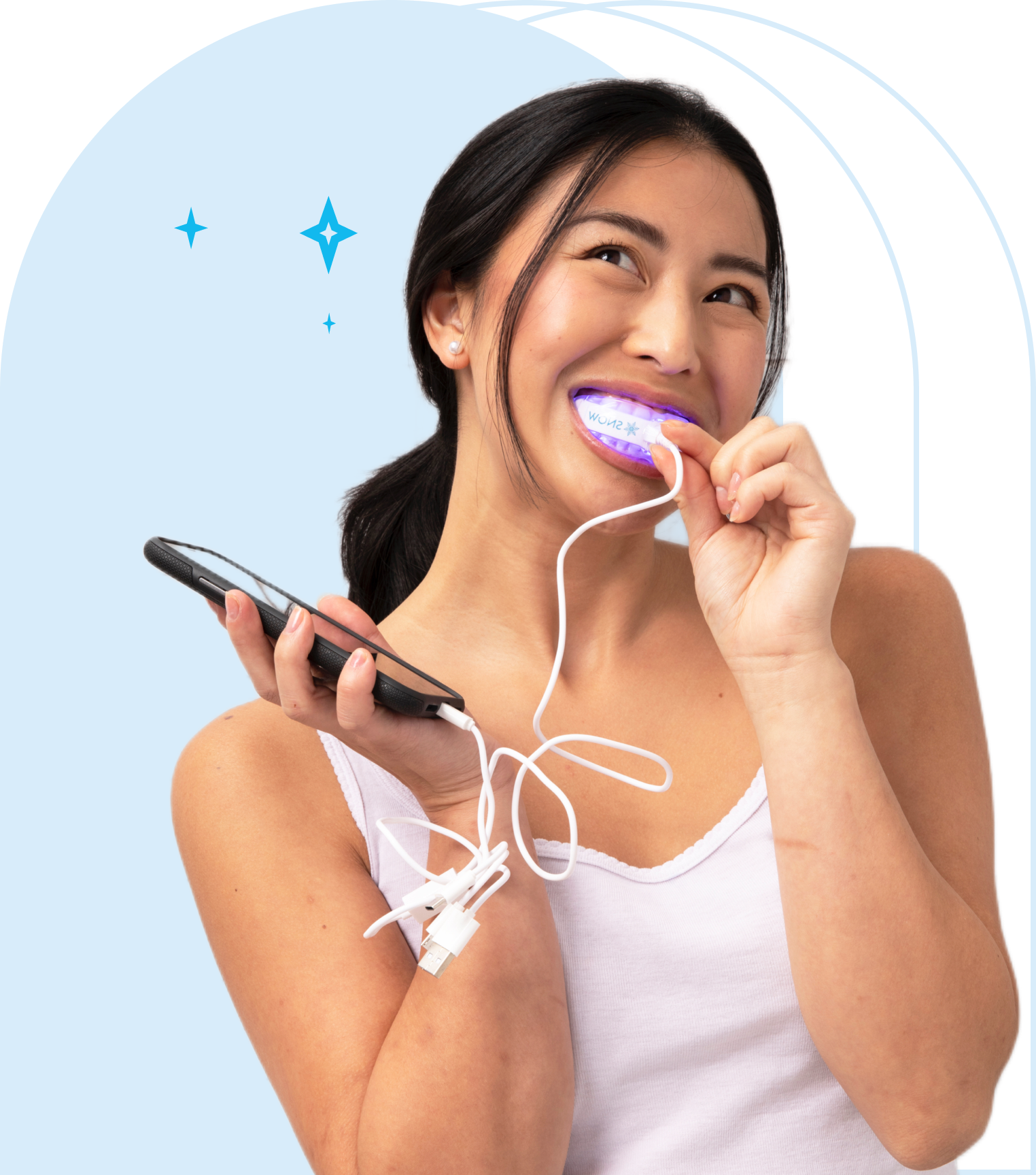After a teeth whitening treatment, many wonder how long teeth pores stay open. The answer matters because your enamel becomes more absorbent, allowing foods and drinks to re-stain your smile. Consuming coffee, wine, or acidic foods too soon can undo your results. Fortunately, with the proper care, you can avoid setbacks and protect your whitening investment. In this guide, learn how long enamel stays porous and what to do to keep your teeth bright and healthy.
Key Takeaways
-
Teeth whitening leaves enamel pores open for 24 to 48 hours, making them vulnerable to staining from foods and drinks.
-
Higher concentrations of bleaching agents in professional treatments can prolong enamel porosity, while at-home kits may extend the treatment duration.
-
Post-whitening care includes avoiding foods and drinks that can cause stains, using a desensitizing toothpaste, and maintaining good dental hygiene to ensure lasting results.
Duration of Enamel Porosity Post-Whitening

Following a teeth whitening procedure, the outer layer of your tooth enamel becomes more porous as part of the whitening process. This porosity occurs when whitening agents penetrate the enamel surface to break up deep stains during the tooth whitening process. As a result, the enamel remains temporarily open and vulnerable to new stains from foods and drinks.
Most sources agree that enamel pores typically stay open for 24 to 48 hours, depending on the concentration of the whitening treatment. During this time, everyday stain-causing items like coffee, tea, or acidic foods should be avoided to prevent re-staining.
Interestingly, a study published in The Angle Orthodontist, using the BET gas adsorption method, found that the enamel pore volume and surface area increased by over 300% after 15 to 30 seconds of acid exposure. This confirms that enamel undergoes significant structural changes immediately after a whitening treatment.
In-office whitening treatments with higher peroxide levels may extend this porous period up to 72 hours, while gentler at-home treatments might allow for faster recovery. Regardless of the method used, this window is considered critical for aftercare.
Understanding how enamel porosity behaves post-whitening can help you better protect your results and maintain a bright smile.
Factors Affecting Pore Closure Time
Understanding what influences how long enamel pores stay open after a teeth whitening procedure can help you protect your results. Here's a breakdown of the key factors:
|
Factor |
Effect on Pore Closure |
|---|---|
|
Bleaching Agent Strength |
Higher concentrations of whitening agents, like hydrogen peroxide, often used in in-office treatments, may extend pore openness up to 72 hours. |
|
Whitening Method |
Professional whitening treatments tend to close pores more quickly than at-home kits, thanks to their shorter application time and stronger formulations. |
|
Tooth Enamel Characteristics |
Individual differences in tooth enamel structure influence the duration of open pores. Some may re-mineralize faster than others. |
|
Dietary Habits |
Consuming acidic foods and staining foods and drinks during the first 48 hours can delay pore closure and increase risk of re-staining. |
|
Tooth Sensitivity |
People with sensitive teeth may benefit from slower or milder treatments, though this may also prolong the time enamel remains porous. |
|
Surface Chemistry |
Research suggests that whitening temporarily increases enamel porosity and surface area, which gradually returns to normal as minerals reabsorb. |
Impact of Staining Susceptibility After Whitening
Immediately after a whitening procedure, your teeth are more vulnerable to stains due to open enamel pores. Foods and drinks can significantly impact your results during this period, particularly within the first 6 to 48 hours.
A 2014 study published in the European Journal of Dentistry found that beverages such as red wine, tea, and cola caused noticeable color changes on bleached teeth within just six hours. Red wine resulted in the most staining, followed by tea and cola. Meanwhile, coffee showed minimal impact, with no statistically significant difference from the control group (artificial saliva).
This heightened susceptibility is linked to increased porosity caused by bleaching agents, such as carbamide peroxide. These open pores allow pigments to penetrate more easily, making the tooth surface highly reactive to colorants during the early stages of recovery.
Want to minimize staining risk while achieving professional-grade results at home? Try the Snow Teeth Whitening Kit, it’s enamel-safe, peroxide-free, and trusted by thousands.
Managing Tooth Sensitivity During Porosity
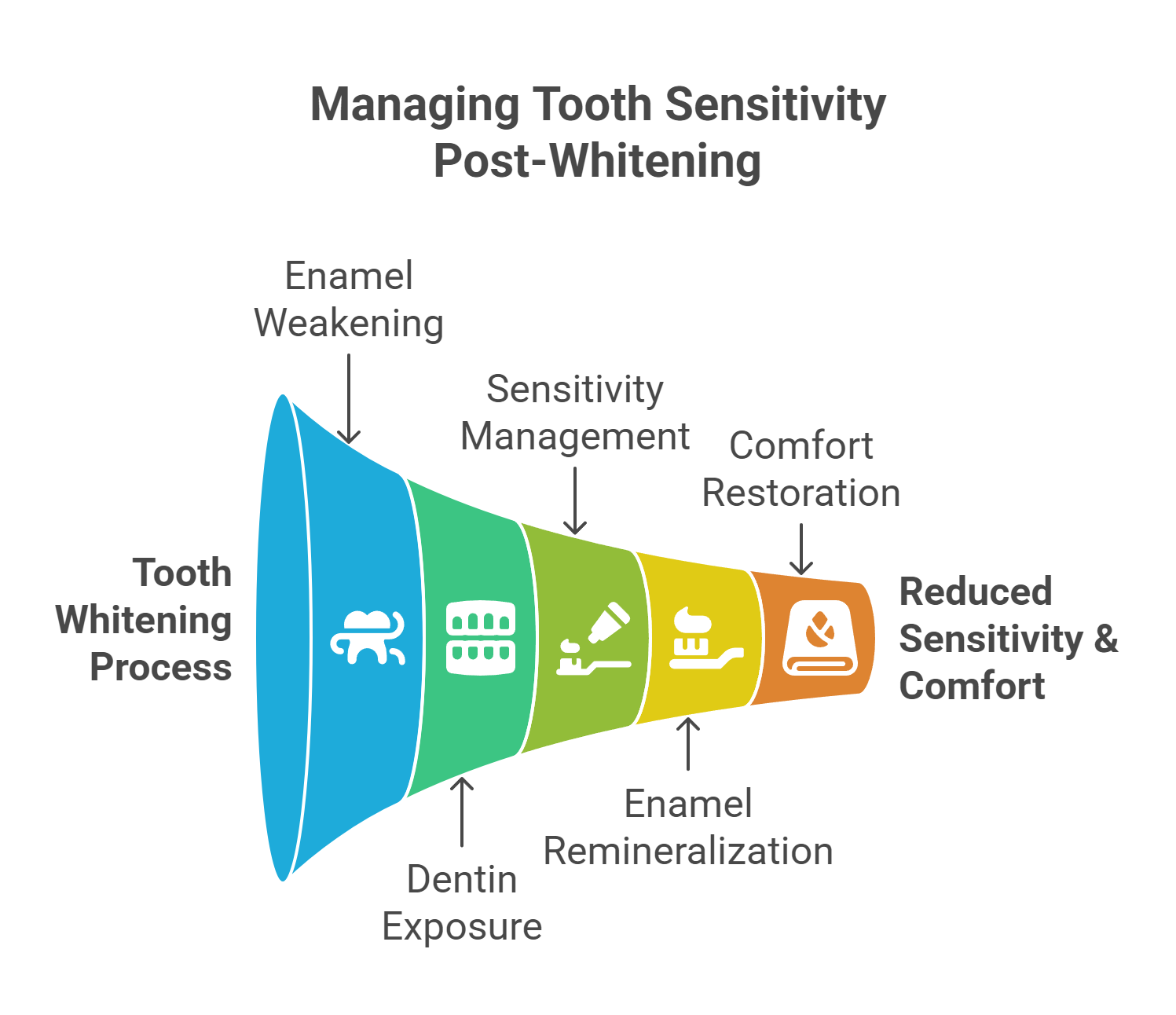
Tooth sensitivity is a common and often uncomfortable side effect of the tooth whitening process. This occurs because the whitening agents temporarily weaken the enamel, creating open pores that can expose the dentin layer beneath. As a result, stimuli like cold air, sweet foods, or hot drinks can trigger sharp discomfort.
This sensitivity is typically short-lived, often lasting two to seven days post-whitening, depending on your enamel condition and the strength of the whitening agent used. In this vulnerable period, your teeth not only absorb stains more easily but also lose moisture. Supporting the rehydration process is essential to restoring enamel balance and comfort.
To help reduce sensitivity, start by using a desensitizing toothpaste that contains potassium nitrate. This ingredient calms nerve endings and helps form a protective layer over exposed areas. Products like the SNOW Sensitive Whitening Serum are specially formulated for post-whitening care and can be applied directly to target discomfort. Additionally, brushing with a fluoride toothpaste, especially one that is ADA-approved, can help remineralize enamel and close open pores more quickly.
You may also benefit from:
-
Using an anti-sensitivity gel (applied before or after whitening)
-
Avoiding very hot or cold foods and drinks during recovery
-
Placing a hot washcloth on your cheek to ease muscle tension or jaw discomfort
-
Eating regular meals that are gentle on your enamel (avoid citrus, spicy, or sugary snacks)
For those using whitening systems at home, such as SNOW, alternating days between treatments or applying the sensitive serum after each session can offer significant relief while still working toward a whiter smile.
By being proactive with aftercare, you can protect your enamel, reduce sensitivity, and maintain a bright, white smile without compromising comfort.
Dietary and Lifestyle Aftercare Following Whitening
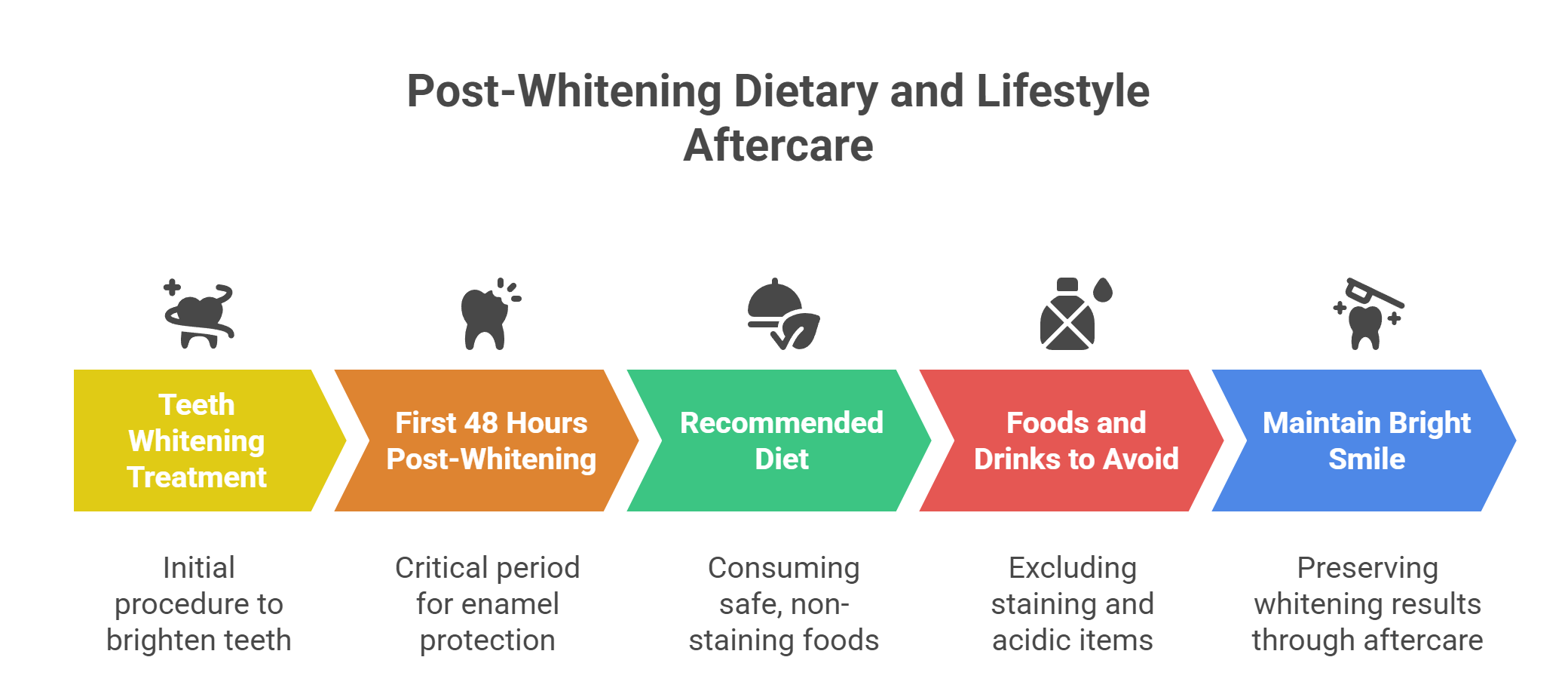
Proper dietary and lifestyle aftercare following a teeth whitening treatment is essential to maintaining your bright smile. During the first 48 hours, your teeth are particularly vulnerable to staining and sensitivity, making it crucial to follow specific guidelines to protect your enamel and prolong the whitening results.
We’ll explore the recommended diet and foods to avoid during this period.
Recommended Diet for the First 48 Hours
During the first 48 hours post-whitening, it’s essential to stick to foods that are less likely to stain your teeth. Safe options include a white diet of:
-
Grilled or baked chicken
-
White rice
-
Pasta with light sauce
-
Eggs
-
Dairy products
-
Bananas
-
Peeled apples
-
Cucumbers
-
Water
-
Milk
These foods are not only gentle on your newly whitened teeth but also help maintain the whitening results.
For breakfast, scrambled eggs are a great choice as they are less likely to stain your teeth. Plain or vanilla yogurt makes for a suitable snack option that won’t affect your whitening results. Following this recommended diet ensures that your teeth remain bright and stain-free during this critical period.
Foods and Drinks to Avoid
Avoiding certain foods and drinks that can lead to re-staining helps preserve your whitening results. Dark-colored beverages to altogether avoid during the first 48 hours post-whitening include:
-
Coffee
-
Tea
-
Dark sodas
-
Red wine
These drinks can quickly stain your teeth, undoing the effects of the whitening treatment.
Highly pigmented foods, such as berries and dark colored foods, should also be excluded from your diet. Additionally, avoiding acidic foods and drinks, including citrus fruits and tomato sauce, can weaken the enamel and increase the risk of staining. By steering clear of these items, you can help maintain the brightness of your smile, which removes surface stains.
Differences by Whitening Method
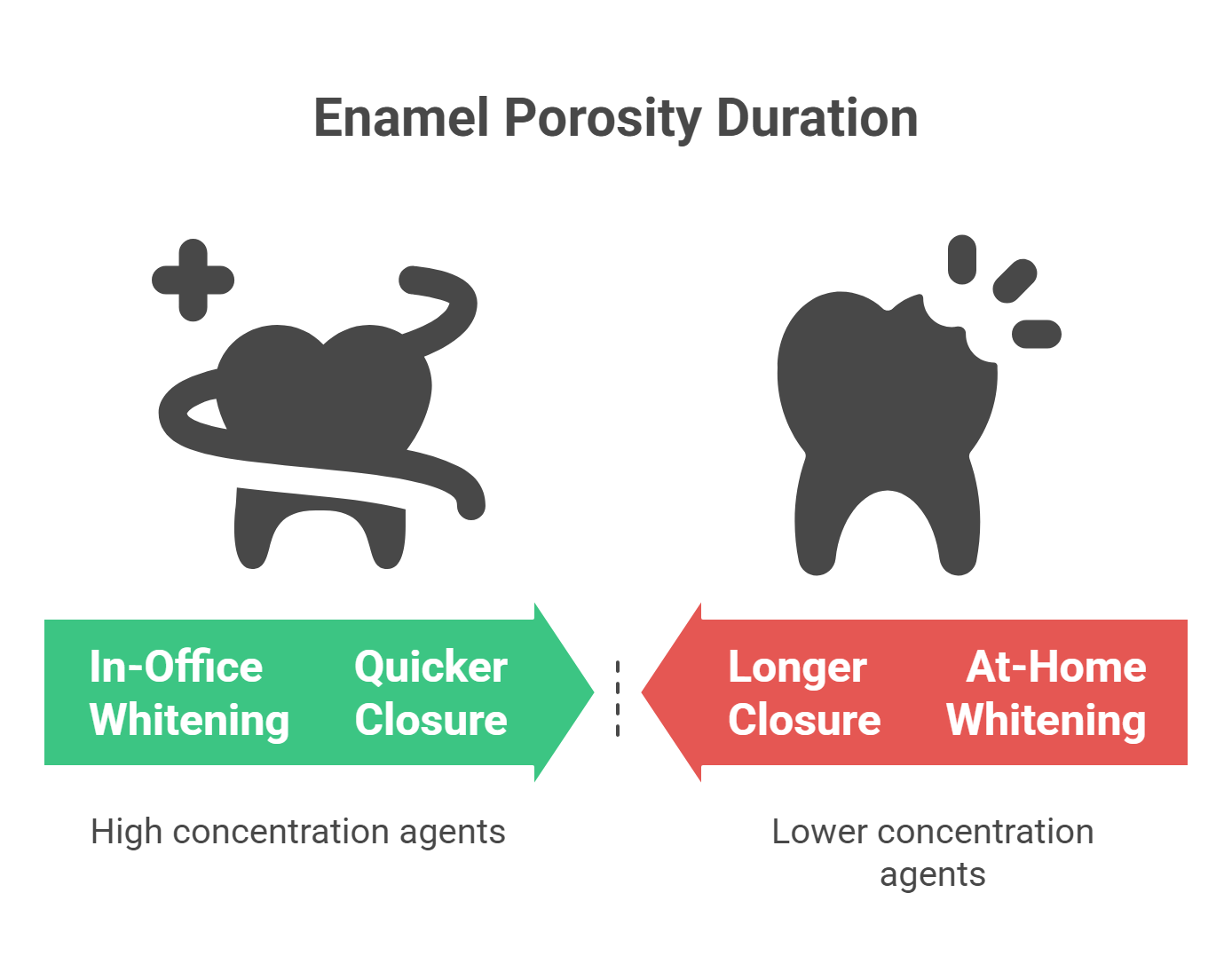
The method of teeth whitening can significantly impact the duration of enamel porosity and the overall whitening results. Professional in-office treatments and at-home whitening kits each have their own advantages and considerations, which we’ll explore in detail in the following subsections.
In-Office Whitening Treatments
Professional teeth whitening treatments often use high-concentration dental bleaching agents, such as Opalescence 10%, Whiteness Perfect 16%, and Whiteness hydrogen peroxide 35%. These agents are designed to deliver rapid and significant whitening results during the teeth whitening process, often resulting in immediate changes to tooth appearance.
Following in-office whitening, your teeth may experience temporary enhanced porosity, which can affect the risk of re-staining until the pores in the enamel close. However, the high concentration of bleaching agents used in professional treatments generally leads to a quicker closure of enamel pores compared to at-home options, making teeth porous a concern for some patients.
At-Home Whitening Kits
At-home whitening kits typically contain lower concentrations of whitening agents, resulting in longer application times and potentially increased enamel porosity after treatment. While these kits may take longer to achieve the desired results, they can help mitigate peak porosity compared to in-office treatments.
The gradual reduction of enamel porosity with at-home kits can be beneficial for individuals with sensitive teeth, as it enables a more controlled whitening process. Opting for lower concentration kits and a longer total treatment time can help achieve a bright smile while minimizing the risk of sensitivity and enamel damage.
Tips for Maintaining Whitening Results After Initial 48 Hours
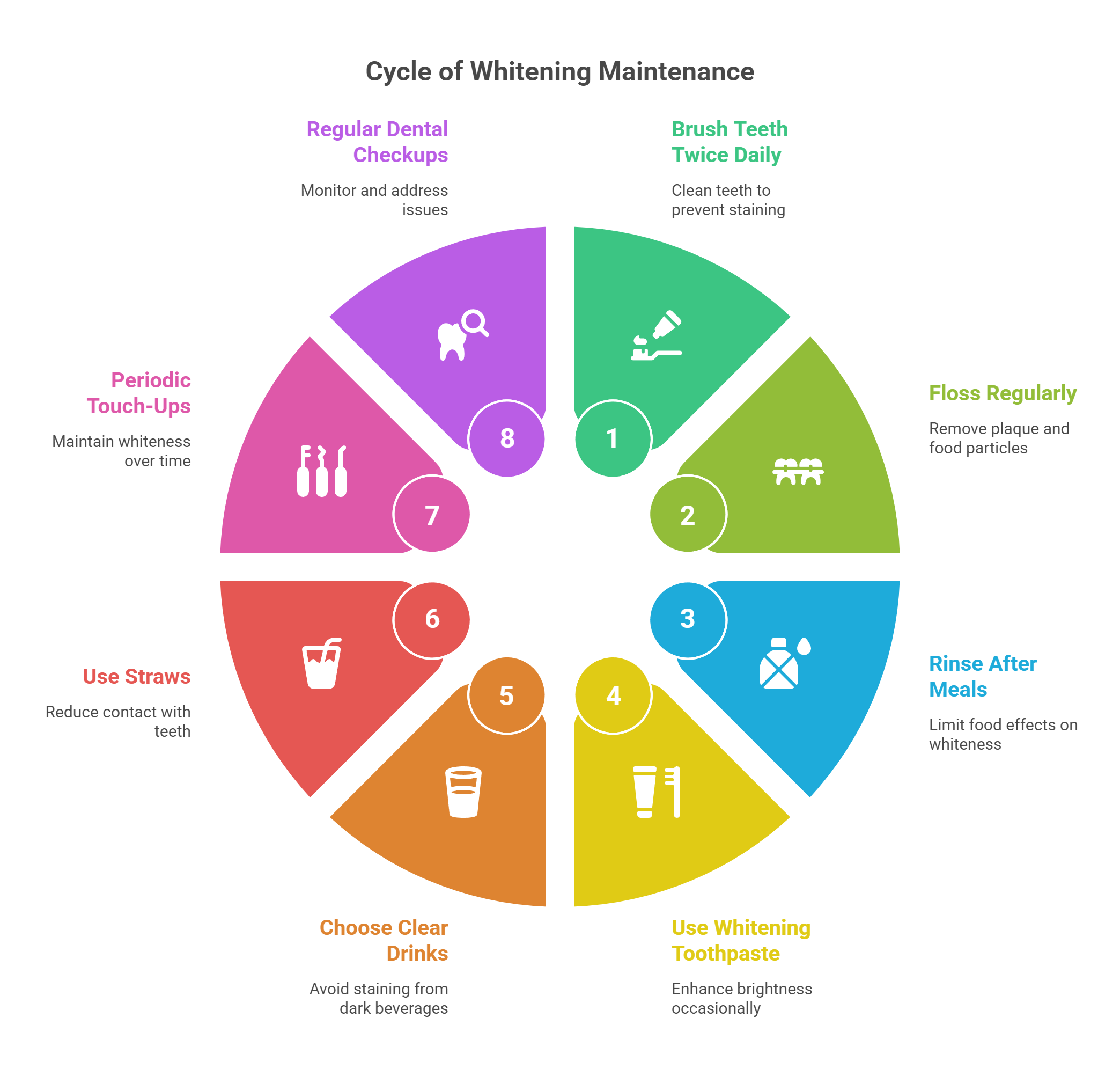
Maintaining your whitening results after the initial 48 hours requires consistent and mindful dental care. Key practices include:
-
Brushing your teeth twice a day
-
Regular flossing to keep your teeth clean and prevent plaque buildup that could affect tooth whiteness
-
Rinsing your mouth after meals helps limit the effects of food on your teeth’s whiteness.
Tips for maintaining the whiteness of your teeth include:
-
Use whitening toothpaste occasionally to keep your teeth looking bright.
-
Opting for clear alcoholic drinks.
-
Using straws when consuming beverages to reduce contact with your teeth and minimize potential staining.
-
Periodic touch-up treatments to help maintain the whiteness of your teeth over time.
Regular dental checkups are crucial for monitoring the condition of your whitened teeth and addressing any potential issues promptly. By following these tips, you can enjoy a long-lasting, bright smile and maximize the benefits of your whitening treatment with cosmetic dental services.
Final Thoughts
Understanding how long enamel pores stay open after whitening and the factors that affect closure is key to preserving your results. During this time, teeth are more prone to stains and sensitivity, so it's essential to follow proper aftercare, avoid staining foods and drinks, and support the recovery of your enamel.
To reduce sensitivity and shield your enamel, consider SNOW’s Sensitive Whitening Serum. It helps create a protective layer while keeping your smile bright and comfortable.
Try SNOW’s serum to protect your results
Frequently Asked Questions
Got questions about teeth whitening aftercare, sensitivity, or what to eat post-treatment? Find quick answers to the most common concerns below.
How long do teeth pores stay open after whitening?
Teeth pores generally stay open for 24 to 48 hours after whitening, and in some cases, they can remain open for up to 72 hours. To maximize results, avoid staining foods and beverages during this period.
What foods can I eat after teeth whitening?
After teeth whitening, you can safely consume grilled or baked chicken, white rice, eggs, dairy products, bananas, and peeled apples. It’s important to avoid colored or acidic foods to maintain your results.
What foods and drinks should I avoid after teeth whitening?
To maintain your teeth whitening results, avoid dark-colored beverages such as coffee, tea, and red wine, as well as highly pigmented foods like berries and dark sauces, along with any acidic foods and drinks. This will help prolong the brightness of your smile.
How can I manage tooth sensitivity after whitening?
To effectively manage tooth sensitivity after whitening, use desensitizing toothpaste and fluoride mouthwash, and consider over-the-counter pain relief if needed. These steps can help alleviate discomfort and protect your teeth.
How can I maintain my whitening results after the initial 48 hours?
To maintain your whitening results after the initial 48 hours, continue proper dental care by brushing and flossing regularly, using whitening toothpaste occasionally, and avoiding stain-causing foods and drinks. Scheduling regular dental checkups is also essential for long-lasting results.

















































